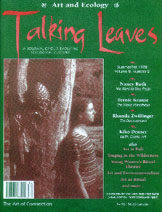So how do art and ecology intermingle? What is their dance about? Art is a form of expression; a way of expressing oneself creatively. It is creative in that it does away with our primary spoken or written language as the way of communicating or it alters how we use that language. Singing takes language and blends it with rhythm, tune, emotion, and harmony--all things present within ourselves and the rest of the natural world. Art as a form of expression implies it is also a form of communication. When you express yourself you communicate what is going on in your soul. Through art we can communicate with nature. We can express what is within us and we can also channel the expressions of other life forms and energies in nature. Art, in its essence, increases our connection with the natural world.
1998 Fall
Singing in the Wilderness
1998 Fall | Jules Bubacz
The Niche Hypothesis: Why Creatures Vocalize and the Relationships Between Natural Sound and Music
1998 Fall | Bernie Krause
As an artist and naturalist, I have long been intrigued by the ways in which night time hunters from non-industrial societies determine types, numbers, and condition of game and other creatures hundreds of meters distant through dark undergrowth by sound where nothing appears to the Western eye or our untrained ear to be especially distinct. It is astounding how closely their music reflects the complex rhythms, polyphonies and sonic textures of the habitats where they live and hunt. Unlike these highly sophisticated groups, we are primarily a visual culture; no longer connected spiritually or aesthetically to what the wild natural can tell us through sound. As a consequence, we've lost a certain aural acuity once central to the dynamic of our lives, profoundly impacting our view of the natural world as abstract and distorted. For me, some insight into our ancient aural past began to unfold about 30 years ago.
A Long Night's Journey Into Day: Or What Do Mt. Shasta, Music, Art, Ecology, and the Beatles Have to Do with One Another?
1998 Fall | Chris Roth
I'd been an organic gardening instructor for several years. Other staff at the educational center I worked at had been encouraging me to write a book about gardening, and this had become one of my wintertime goals--but I couldn't help but be bored and vaguely uncomfortable with the idea. What could I write that hadn't already been written elsewhere? For someone in his mid-thirties with barely over a decade of gardening and farming experience to pretend to be more expert than the thousands of lifetime gardeners who have never written books seemed presumptuous at best. Short articles and newsletter contributions were more up my alley, not a book.
We Want to Stay Frogs
1998 Fall | Hondi Brasco | Nancy Roth
The story of our revised "Frog Prince" was itself an example of metamorphosis. Grimm, the author of the fairy tale, had assumed that frogs would prefer to be princes. Willie and David had helped us stretch our imaginations through their raucous croaks and their energetic jumps around the room, so that, indeed, being a prince began to seem a little boring. They helped us all--even the little girls, who definitely wanted to "stay princesses"--understand that human beings are part of the circle of creation, including princesses, pools, frogs, and the flowers climbing the castle wall. (The truth is that, given the choice, it is unlikely that any frog today would change his place for a prince, especially in this day of tabloids and paparazzi!)
Ecological Art
1998 Fall | Katherine Kormendi
Ecological art springs from a long tradition--one that, in the United States at least, dates back to the 19th century. Landscape painters from the Hudson River School were among the first to warn of the danger of "the wilderness passing away and the necessity of saving and perpetuating its features," as Thomas Cole, founder of the Hudson River School expressed it. Their panoramic vistas romantically documented the wilderness they sought to preserve and occasionally contained foreboding images of industrial encroachment as well. In Andrew Melrose's "Westward the Star of the Empire Takes its Way," the blinding glare of a train's searchlight shines out against the darkening evening sky with prophetic implications. However obscured by the self-referential painterly traditions which culminated in Abstract Expressionism and Post Expressionism, both impulses of the Hudson River School--the celebration of nature and the depiction of technology's encroachment--have lived on through Ryder, Homer, and Hopper, to name just a few, well into our times.
